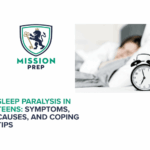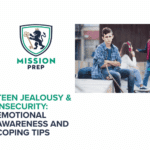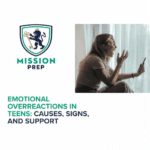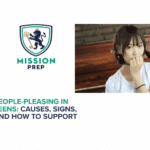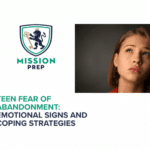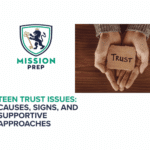Conflict Avoidance in Teens: Causes, Signs, and How to Encourage Healthy Communication

Resolving conflicts is part of healthy relationships. Even when you are talking to close friends and family, inevitably, there will be topics of disagreement.
Adolescence is a time when new interpersonal relationships are formed and existing relationships grow. Teens make new friends, interact with different family members, and take direction from teachers or coaches – these interactions are all part of their social development. However, some teens struggle to maintain relationships when conflicts emerge.
By nature, conflict can be challenging. But, depending on past experiences, personality traits, and ways of processing emotions, certain teens might avoid conflict altogether. At first, this pattern might seem like they are trying to keep the peace, yet, eventually, conflict avoidance in teens can become detrimental to their mental health.
Conflict avoidance may signal suppressed emotions, and, if left unmanaged, could lead to mental health issues such as anxiety and depression. This page can help you better understand and navigate conflict avoidance in teens by covering:
- The negative effects of conflict avoidance
- Causes of avoidance in adolescence
- Recognizing signs of avoidance in teens
- Early intervention for social difficulties
- Parental guidance for communication skills

The Negative Effects of Conflict Avoidance
Avoiding unnecessary arguments can be a healthy trait, as it can prevent emotions from escalating. However, when conflict avoidance in teens becomes a go-to pattern of behavior, it may signal something deeper than just wanting to “keep the peace.”
Teen conflict avoidance is considered a maladaptive approach to conflict resolution. Rather than addressing the issue at hand and asserting themselves, a teen steers clear of the situation. This behavior not only leads to avoidance of arguments, but potentially also family members, friends, teachers, and anyone else that an adolescent fears will disagree with them on a subject.
Understandably, studies show that conflict avoidance is tied to negative psychological outcomes in teens. Specifically, teens who avoid family conflict show more signs of mental health problems and report lower life satisfaction overall.1
Additionally, as conflict avoidance can lead to social withdrawal and isolation, it’s associated with depression and anxiety in teens. And, while it can initially prevent negative emotions from escalating, it provides no resolution for problems. Therefore, in the long run, it may lead to more anger in teens that spills over into different areas of their lives.2
Further, when we look at early romantic relationships during adolescence, conflict avoidance is tied to lower trust and commitment.2
Since it is clear that avoiding conflict isn’t an effective strategy in relationships, the issue needs to be addressed early so teens can learn more adaptive conflict resolution strategies.
Causes of Avoidance in Adolescence
Many factors in a child’s life can lead them to avoid conflict. A few of the major causes of avoidance in adolescence, according to research, are personality traits, bullying, and attachment styles. We discuss the research around each of these potential causes in the following sections.
Personality Traits
One model of personality is the Five-Factor Model (FFM). The FFM is based on the idea that there are five dimensions of personality that people experience to varying degrees: neuroticism, extraversion, openness, conscientiousness, and agreeableness.3
Research shows that certain dimensions are closely related to how teens deal with conflict. For example, neuroticism is the tendency to experience negative emotions. Therefore, people who score high in this dimension often tend to show more signs of depression, vulnerability, and self-consciousness when faced with conflict, leading them to avoid social situations. Additionally, low levels of extraversion are linked to less assertiveness in social situations; therefore, someone with these lower levels may be more likely to avoid conflict.3
Bullying in Teens
Bullying has always been a major problem for adolescents because it is closely tied to the development of negative coping strategies (amongst other issues). As a result of bullying, children may try to cope by avoiding any social situations with potential for conflict rather than approaching them in attempts to resolve them.4
Further, research shows that when these children turn to avoidant coping strategies following bullying, they’re less likely to be able to effectively solve problems in the future.4
Attachment Style
Early relationships between parents and children typically determine a child’s attachment style. In general, attachment tends to fall into two categories: secure attachment and insecure attachment.
Secure attachment means that a child feels safe in relationships, receives adequate physical and emotional support, and trusts others. On the other hand, insecure attachment styles are tied to inconsistent, rejecting, or neglectful parenting. For example, a parent who alternates between praising and punishing a child for similar behaviors, or rejects their attempts at emotional closeness, could promote insecure attachment.5
Adolescents that show insecure attachment are more likely to use avoidant strategies to deal with conflicts. For instance, a teen might withdraw from social situations, show signs of fear, and voice negative perceptions of themselves.5
These three causes of avoidance in adolescence have been supported by years of research. However, there are always new studies being conducted – therefore, other factors related to avoidance may be gaining additional recognition.
Recognizing Signs of Avoidance in Teens
Shyness is sometimes associated with social avoidance in teens, but shyness alone isn’t cause for concern – not everyone wants to make speeches or stand up on a stage. But if a teen is withdrawing from their friends and spending most of their time alone, this may be a sign of something more than shyness.
Recognizing signs of avoidance in teens involves paying attention to subtle changes in behavior, in addition to more obvious tendencies. As mentioned, a major sign of avoidance is withdrawal from friends. However, other, more subtle signs can include seeking out activities to do alone. For instance, your child might have always enjoyed reading. Yet if the amount of time they spend alone with a book is increasing and it’s interfering with other obligations, they could be showing signs of social difficulties.6
When a child is hesitant to speak up to ask for what they need in a relationship, this can also indicate they are using avoidant behaviors. For example, if you notice that your child has been quieter lately or they aren’t initiating conversations, consider whether they are struggling with social difficulties.6
Additionally, signs of depression are also tied to avoidance in teens. Therefore, depressed mood, negative self-talk, and increased stress that impact relationships are all indicators of avoidance in teens. Social anxiety may also contribute to increased time spent alone due to fears about judgment or rejection.6
Early Intervention for Social Difficulties
There are a variety of options for early intervention for social difficulties, including therapy for social anxiety.
Cognitive behavioral therapy (CBT) is one of the first lines of treatment for teens with social anxiety. CBT is usually a short-term, skills-based therapy. Skills focus on changing negative thought patterns and maladaptive behaviors (like social avoidance). Additionally, exposure to different situations in a therapeutic setting can promote positive coping strategies for conflicts that may arise in other scenarios.
By promoting healthy communication, CBT can helps teens become more confident in their social skills so they aren’t as quick to avoid events out of fear. CBT also places emphasis on emotion regulation skills in teens. Therefore, when panic and fear arise, the child is taught to restructure their thoughts and practice mindfulness relaxation to physically calm the body down from a state of hyperarousal.
Cognitive behavioral group therapy (CBGT) is another effective treatment method for social anxiety in teens. This type of therapy incorporates the standard skills from CBT as well as psychoeducation, skills training sessions, and structured exposure activities.7
Other treatment option for social anxiety in teens is social effectiveness therapy. Social effectiveness therapy combines exposure, social skills instruction, and psycho-education to support assertiveness in teens and build confidence in adolescence across a variety of social situations.
Additionally, mindfulness-based therapy can include aspects of meditation, deep breathing, and progressive muscle relaxation to encourage better emotion regulation in teens when faced with anxiety-provoking situations.7
Along with therapy, anti-anxiety medications can be effective in treating social anxiety in teens. As can antidepressants such as Fluoxetine (Prozac), Fluvoxamine (Luvox), Paroxetine (Paxil), and Venlafaxine (Effexor). A combination of therapy and medication often provides the best outcomes for teens who need control over symptoms before feeling capable of learning the skills taught in therapy.7
Parental Guidance for Communication Skills
Engaging parents in the therapeutic process is often important for teens with social anxiety. Parents can support their children by becoming educated about social anxiety and positive communication skills, and even by exploring their own feelings around difficult behaviors in the home.
In particular, CBT directly involves parents in therapy sessions focused on psychoeducation. By learning about the struggles your child is experiencing and which coping skills can help them, you can be better equipped to promote healthy communication. Another type of therapy that specifically focuses on parental support is cognitive parent training (CPT). This involves addressing any problematic thoughts and behaviors that parents are experiencing in response to their child’s anxiety.8
Additionally, family therapy sessions can be used to encourage parents to model appropriate behavior in the home. For example, parents can learn the specific communication skills that their children are working on in therapy. They can also discover the signs to look for if the child is struggling to use these skills in the home. Based on the training you receive, you might offer your child choices if they’re showing signs of indecision during interactions. This can specifically help with building confidence in adolescents.8

Mission Prep: Supporting Teen Wellness and Social Skills
At Mission Prep, our mental health treatment options are centered on the goal of supporting teen wellness and social skills. If you notice your child struggling with conflict avoidance, social anxiety, generalized anxiety, or any concerning mental health issue, our team can find the right therapeutic intervention for your family.
From outpatient CBT programs to residential mental health treatment facilities, our options can target all levels of severity depending on your child’s needs. We understand how overwhelming it can be to seek help for your child during a challenging time. For this reason, we aim to make the process as compassionate and individualized as possible.
Call us today or fill in our confidential online form if you want to find out more about our treatment options or simply wish to ask questions about your child’s symptoms and options.
References
- Ubinger, M. E., Handal, P. J., & Massura, C. E. (2013). Adolescent adjustment: The hazards of conflict avoidance and the benefits of conflict resolution. Psychology, 4(1), 50–58. https://doi.org/10.4236/psych.2013.41007
- Overall, N. C., Simpson, J. A., & Struthers, H. (2013). Buffering attachment-related avoidance: Softening emotional and behavioral defenses during conflict discussions. Journal of Personality and Social Psychology, 104(5), 854–871. https://doi.org/10.1037/a0031798
- Sandy, S. V., Boardman, S. K., & Deutsch, M. (2000). Personality and conflict. In M. Deutsch & P. T. Coleman (Eds.), The handbook of conflict resolution: Theory and practice (pp. 289–315). Jossey-Bass.
- Hunter, S. C., Mora-Merchán, J., & Ortega, R. (2004). The long-term effects of coping strategy use in victims of bullying. The Spanish Journal of Psychology, 7(1), 3–12. https://pubmed.ncbi.nlm.nih.gov/15139244/
- Yildiz, B. (2023). Attachment, growth fear and conflict resolution in close relationships. International Journal of Psychology and Educational Studies, 10(2), 453–462. https://ijpes.com/index.php/ijpes/article/view/1011
- Bowker, J. C., & Raja, R. (2011). Social withdrawal subtypes during early adolescence in India. Journal of Abnormal Child Psychology, 39(2), 201–212. https://psycnet.apa.org/record/2011-03854-004
- Kara, A. (2022). Current treatments for social anxiety disorder in adolescents: A narrative review. Unico’s Review, 1(1–2), 5–10.
- Peris, T. S., Thamrin, H., & Rozenman, M. S. (2021). Family intervention for child and adolescent anxiety: A meta-analytic review of therapy targets, techniques, and outcomes. Journal of Affective Disorders, 286, 282–295. https://doi.org/10.1016/j.jad.2021.02.062

